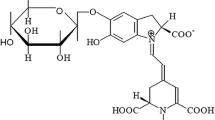Abstract
The effects of ß-glucan isolated fromAureobasidium pullulans were observed on acute xylene-induced inflammation, ß-glucan at a dose of 62.5, 125 or 250 mg/kg were administered once orally to xylene-treated mice (0.03 mL of xylene was applied on the anterior surface of the right ear to induce inflammation), and the body weight change, ear weight, histological profiles and histomorphometrical analyses of ear were conducted upon sacrifice. The xylene was topically applied 30min after dosing with ß-glucan. The results were compared to those of diclofenac, indomethacin and dexamethasone (15 mg/kg injected once intraperitoneally). All animals were sacrificed 2 h after xylene application. Xylene application resulted in marked increases in induced ear weights compared to that of intact control ear; hence, the differences between intact and induced ear were also significantly increased. The histological characteristics of acute inflammation, such as severe vasodilation, edematous changes of skin and infiltration of inflammatory cells, were detected in xylene-treated control ears with marked increase in the thickness of the ear tissues. However, these xylene-induced acute inflammatory changes were significantly and dose-dependently decreased by ß-glucan treatment. We conclude that ß-glu-can fromA. pullulans has a somewhat favorable effect in the reduction of the acute inflammatory responses induced by xylene application in mice.
Similar content being viewed by others
References
Al-Majed, A. A., Khattab, M., Raza, M., Al-Shabanah, O. A., and Mostafa, A.M., Potentiation of diclofenac-induced anti- inflammatory response by aminoguanidine in carrageenan- induced acute inflammation in rats: the role of nitric oxide.Inflamm. Res., 52, 378–382 (2003).
Amin, A. R., Vyas, P., Attur, M., Leszczynska-Piziak, J., Patel, I. R., Weissmann, G, and Abramson, S. B., The mode of action of aspirin-like drugs: effect on inducible nitric oxide synthase.Proc. Natl. Acad. Sci. U.S.A., 92, 7926–7930 (1995).
Bell, S., Goldman, V. M., Bistrian, B. R., Arnold, A. H., Ostroff, G, and Forse, R. A., Effect of beta-glucan from oats and yeast on serum lipids.Crit. Rev. Food Sci. Nutr., 39, 189–202 (1999).
Czop, J. K., The role of beta-glucan receptors on blood and tissue leukocytes in phagocytosis and metabolic activation.Pathol. Immunopathol. Res., 5, 286–296 (1986).
De LaPuerta, R., Martinez, E., Bravo, L., and Ahumada, M. C., Effect of Silymarin on different acute inflammation models and on leukocyte migration.J. Pharm. Pharmacol., 48, 968- 970 (1996).
Di Renzo, L, Yefenof, E., and Klein, E., The function of human NK cells is enhanced by beta-glucan, a ligand of CR3 (CD11b/CD18).Eur. J. Immunol., 21, 1755–1758 (1991).
Estrada, A., Yun, C. H., Van Kessel, A., Li, B., Hauta, S., and Laarveld, B., Immunomodulatory activities of oat beta-glucanin vitro andin vivo.Microbiol. Immunol., 41, 991–998 (1997).
Habashy, R. R., Abdel-Naim, A. B., Khalifa, A. E., and Al-Azizi, M. M., Anti-inflammatory effects of jojoba liquid wax in experimental models.Pharmacol. Res., 51, 95–105 (2005).
Hosseinzadeh, H., Haddadkhodaparast, M. H., and Arash, A. R., Antinociceptive, antiinflammatory and acute toxicity effects ofSalvia leriifolia Benth seed extract in mice and rats.Phytother. Res., 17, 422–425 (2003).
Hosseinzadeh, H., and Younesi, H. M., Antinociceptive and anti-inflammatory effects ofCrocus sativus L. stigma and petal extracts in mice.BMC Pharmacol., 2, 7–12 (2002).
Kou, J., Ma, R., Zhu, D., and Yan, Y, Blood-activating and anti- inflammatory actions ofPolygala fallax.Zhong Yao Cai, 26, 268–271 (2003).
Kou, J., Ni, Y, Li, N., Wang, J., Liu, L, and Jiang, Z. H., Analgesic and anti-inflammatory activities of total extract and individual fractions of Chinese medicinal antsPolyrhachis lamellidens.Biol. Pharm. Bull., 28, 176–180 (2005).
Krizkova, L, Durackova, Z., Sandula, J., Slamenova, D., Sasinkova, V, Sivonova, M., and Krajcovic, J., Fungal beta- (1-3)-D-glucan derivatives exhibit high antioxidative and antimutagenic activityin vitro.Anticancer Res., 23, 2751–2756 (2003).
Lia, A., Hallmans, G, Sandberg, A. S., Sundberg, B., Aman, P., and Andersson, H., Oat beta-glucan increases bile acid excretion and a fiber-rich barley fraction increases cholesterol excretion in ileostomy subjects.Am. J. Clin. Nutr., 62, 1245–1251 (1995).
Liu, F., Ooi, V. E., and Chang, S. T, Free radical scavenging activities of mushroom Polysaccharide extracts.Life Sci., 60, 763–771 (1997).
Ojewole, J. A., Antinociceptive, anti-inflammatory and antidiabetic effects ofBryophyllum pinnatum (Crassulaceae) leaf aqueous extract.J. Ethnopharmacol., 99, 13–19 (2005).
Ramprasath, V. R., Shanthi, P., and Sachdanandam, P., Immu- nomodulatory and anti-inflammatory effects ofSemecarpus anacardium LINN. Nut milk extract in experimental inflammatory conditions.Biol. Pharm. Bull., 29, 693–700 (2006).
Ross, G. D., Vetvicka, V, Yan, J., Xia, Y, and Vetvickova, J., Therapeutic intervention with complement and beta-glucan in cancer.Immunopharmacology, 42, 61–74 (1999).
Rotelli, A. E., Guardia, T., Juarez, A. O., de laRocha, N. E., and Pelzer, L. E., Comparative study of flavonoids in experimental models of inflammation.Pharmacol. Res., 48, 601–606 (2003).
Sener, G., Toklu, H., Ercan, F., and Erkanli, G., Protective effect of beta-glucan against oxidative organ injury in a rat model of sepsis.Int. Immunopharmacol., 5, 1387–1396 (2005).
Seo, H. P., Kim, J. M., Shin, H. D., Kim, T. K., Chang, H. J., Park, B. R., and Lee, J. W., Production of-1,3/1,6-glucan byAureobasidium pullulans SM-2001.Korean J. Biotechnol. Bioeng., 17, 376–380 (2002).
Author information
Authors and Affiliations
Corresponding author
Rights and permissions
About this article
Cite this article
Kim, HD., Cho, HR., Moon, Sb. et al. Effects of ß-glucan fromAureobasidium pullulans on acute inflammation in mice. Arch Pharm Res 30, 323–328 (2007). https://doi.org/10.1007/BF02977613
Received:
Issue Date:
DOI: https://doi.org/10.1007/BF02977613




